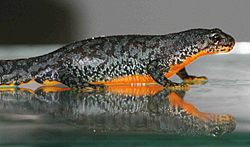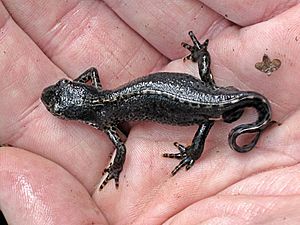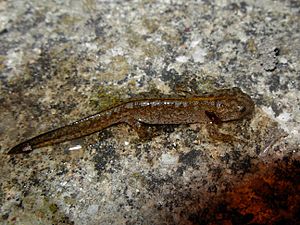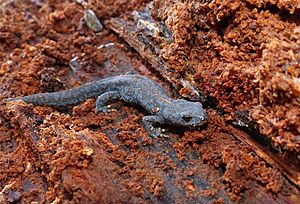Alpine newt facts for kids
Quick facts for kids Alpine newt |
|
|---|---|
 |
|
| Conservation status | |
| Scientific classification | |
| Kingdom: | |
| Class: | |
| Order: | |
| Family: | |
| Genus: |
Triturus
|
| Binomial name | |
| Triturus alpestris |
|
The alpine newt (Triturus alpestris) is a type of amphibian. It is a Salamander, which is a group of amphibians with tails. The alpine newt is one of five different newt species found in Germany.
Contents
About the Alpine Newt
What They Look Like
When it's time to mate early in the year, male alpine newts get a cool blue color on their sides. This blue doesn't cover their white-and-black spotted flanks. Their bellies turn a bright orange. Female newts are usually more camouflaged. They have a mottled brown color with black spots that are hard to see. This helps them blend in with their marshy homes.
The largest males can grow up to nine centimeters long. Females can be even bigger, reaching up to twelve centimeters. After the mating season, both males and females return to their usual mottled brown color.

Where They Live and What They Do
Alpine newts usually live in forests that have plenty of water. They prefer hilly or mountainous areas. You won't often find them in places without many trees. They love thick forests with deciduous trees (trees that lose their leaves). They can also be found in natural gardens that have ponds.
When it's not the season for laying eggs, the alpine newt lives on land. During the day, it hides in plants and other ground cover. But during the mating season, they move into cool water, like forest ponds or even artificial pools. After they wake up from their winter sleep, adult newts go straight to these pools to lay their eggs.
Where You Can Find Them
Alpine newts mostly live in Central Europe. You can also find them in some mountainous parts of Southern Europe. There's also a small, separate group living on the Iberian Peninsula.
Some wild groups have also been introduced to the UK.
Are They in Danger?
The number of alpine newts dropped a lot in the 1960s and 1970s. But since then, their numbers have started to recover a bit. Studies near Cologne (which is about 50 meters above sea level) showed more alpine newts overall. However, the number of newts in their breeding pools seemed to go down.
In home gardens, newts sometimes settle in ponds. They can have many babies in these ponds. But if fish are in the same pond, the newt population might disappear completely. For example, a small pond of 150 liters had over 60 alpine newt tadpoles in July 2003. These were likely all from just one female newt!
Images for kids
-
Biofluorescence in an alpine newt
-
Shady ponds surrounded by forest (here in the Vosges, France) are typical breeding sites for alpine newts.
See Also
 In Spanish: Tritón alpino para niños
In Spanish: Tritón alpino para niños













